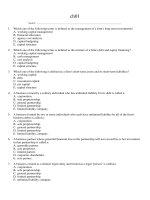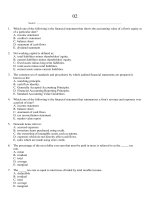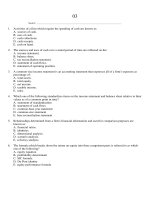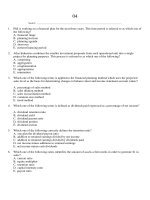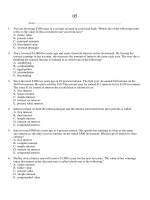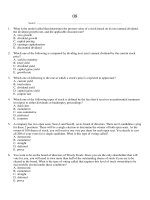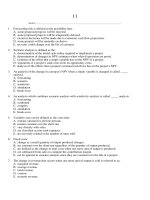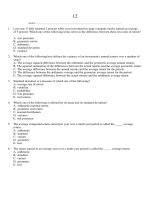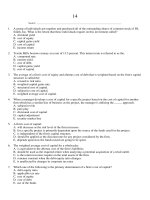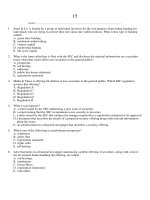Test bank fundamentals of corporate finance 9th edition chap003
Bạn đang xem bản rút gọn của tài liệu. Xem và tải ngay bản đầy đủ của tài liệu tại đây (348.16 KB, 89 trang )
Chapter 03 - Working with Financial Statements
Chapter 03
Working with Financial Statements
Multiple Choice Questions
1. Activities of a firm which require the spending of cash are known as:
A. sources of cash.
B. uses of cash.
C. cash collections.
D. cash receipts.
E. cash on hand.
2. The sources and uses of cash over a stated period of time are reflected on the:
A. income statement.
B. balance sheet.
C. tax reconciliation statement.
D. statement of cash flows.
E. statement of operating position.
3. A common-size income statement is an accounting statement that expresses all of a firm's
expenses as percentage of:
A. total assets.
B. total equity.
C. net income.
D. taxable income.
E. sales.
4. Which one of the following standardizes items on the income statement and balance sheet
relative to their values as of a common point in time?
A. statement of standardization
B. statement of cash flows
C. common-base year statement
D. common-size statement
E. base reconciliation statement
3-1
Chapter 03 - Working with Financial Statements
5. Relationships determined from a firm's financial information and used for comparison
purposes are known as:
A. financial ratios.
B. identities.
C. dimensional analysis.
D. scenario analysis.
E. solvency analysis.
6. The formula which breaks down the return on equity into three component parts is referred
to as which one of the following?
A. equity equation
B. profitability determinant
C. SIC formula
D. Du Pont identity
E. equity performance formula
7. The U.S. government coding system that classifies a firm by the nature of its business
operations is known as the:
A. NASDAQ 100.
B. Standard & Poor's 500.
C. Standard Industrial Classification code.
D. Governmental ID code.
E. Government Engineered Coding System.
8. Which one of the following is a source of cash?
A. increase in accounts receivable
B. decrease in notes payable
C. decrease in common stock
D. increase in accounts payable
E. increase in inventory
3-2
Chapter 03 - Working with Financial Statements
9. Which one of the following is a use of cash?
A. increase in notes payable
B. decrease in inventory
C. increase in long-term debt
D. decrease in accounts receivables
E. decrease in common stock
10. Which one of the following is a source of cash?
A. repurchase of common stock
B. acquisition of debt
C. purchase of inventory
D. payment to a supplier
E. granting credit to a customer
11. Which one of the following is a source of cash?
A. increase in accounts receivable
B. decrease in common stock
C. decrease in long-term debt
D. decrease in accounts payable
E. decrease in inventory
12. On the Statement of Cash Flows, which of the following are considered financing
activities?
I. increase in long-term debt
II. decrease in accounts payable
III. interest paid
IV. dividends paid
A. I and IV only
B. III and IV only
C. II and III only
D. I, III, and IV only
E. I, II, III, and IV
3-3
Chapter 03 - Working with Financial Statements
13. On the Statement of Cash Flows, which of the following are considered operating
activities?
I. costs of goods sold
II. decrease in accounts payable
III. interest paid
IV. dividends paid
A. I and III only
B. III and IV only
C. I, II, and III only
D. I, III, and IV only
E. I, II, III, and IV
14. According to the Statement of Cash Flows, a decrease in accounts receivable will _____
the cash flow from _____ activities.
A. decrease; operating
B. decrease; financing
C. increase; operating
D. increase; financing
E. increase; investment
15. According to the Statement of Cash Flows, an increase in interest expense will _____ the
cash flow from _____ activities.
A. decrease; operating
B. decrease; financing
C. increase; operating
D. increase; financing
E. increase; investment
16. On a common-size balance sheet all accounts are expressed as a percentage of:
A. sales for the period.
B. the base year sales.
C. total equity for the base year.
D. total assets for the current year.
E. total assets for the base year.
3-4
Chapter 03 - Working with Financial Statements
17. On a common-base year financial statement, accounts receivables will be expressed
relative to which one of the following?
A. current year sales
B. current year total assets
C. base-year sales
D. base-year total assets
E. base-year accounts receivables
18. A firm uses 2008 as the base year for its financial statements. The common-size, base-year
statement for 2009 has an inventory value of 1.08. This is interpreted to mean that the 2009
inventory is equal to 108 percent of which one of the following?
A. 2008 inventory
B. 2008 total assets
C. 2009 total assets
D. 2008 inventory expressed as a percent of 2008 total assets
E. 2009 inventory expressed as a percent of 2009 total assets
19. Which of the following ratios are measures of a firm's liquidity?
I. cash coverage ratio
II. interval measure
III. debt-equity ratio
IV. quick ratio
A. I and III only
B. II and IV only
C. I, III, and IV only
D. I, II, and III only
E. I, II, III, and IV
20. An increase in current liabilities will have which one of the following effects, all else held
constant? Assume all ratios have positive values.
A. increase in the cash ratio
B. increase in the net working capital to total assets ratio
C. decrease in the quick ratio
D. decrease in the cash coverage ratio
E. increase in the current ratio
3-5
Chapter 03 - Working with Financial Statements
21. An increase in which one of the following will increase a firm's quick ratio without
affecting its cash ratio?
A. accounts payable
B. cash
C. inventory
D. accounts receivable
E. fixed assets
22. A supplier, who requires payment within ten days, should be most concerned with which
one of the following ratios when granting credit?
A. current
B. cash
C. debt-equity
D. quick
E. total debt
23. A firm has an interval measure of 48. This means that the firm has sufficient liquid assets
to do which one of the following?
A. pay all of its debts that are due within the next 48 hours
B. pay all of its debts that are due within the next 48 days
C. cover its operating costs for the next 48 hours
D. cover its operating costs for the next 48 days
E. meet the demands of its customers for the next 48 hours
24. Over the past year, the quick ratio for a firm increased while the current ratio remained
constant. Given this information, which one of the following must have occurred? Assume all
ratios have positive values.
A. current assets increased
B. current assets decreased
C. inventory increased
D. inventory decreased
E. accounts payable increased
3-6
Chapter 03 - Working with Financial Statements
25. Ratios that measure a firm's financial leverage are known as _____ ratios.
A. asset management
B. long-term solvency
C. short-term solvency
D. profitability
E. book value
26. Which one of the following statements is correct?
A. If the total debt ratio is greater than .50, then the debt-equity ratio must be less than 1.0.
B. Long-term creditors would prefer the times interest earned ratio be 1.4 rather than 1.5.
C. The debt-equity ratio can be computed as 1 plus the equity multiplier.
D. An equity multiplier of 1.2 means a firm has $1.20 in sales for every $1 in equity.
E. An increase in the depreciation expense will not affect the cash coverage ratio.
27. If a firm has a debt-equity ratio of 1.0, then its total debt ratio must be which one of the
following?
A. 0.0
B. 0.5
C. 1.0
D. 1.5
E. 2.0
28. The cash coverage ratio directly measures the ability of a firm's revenues to meet which
one of its following obligations?
A. payment to supplier
B. payment to employee
C. payment of interest to a lender
D. payment of principle to a lender
E. payment of a dividend to a shareholder
3-7
Chapter 03 - Working with Financial Statements
29. Jasper United had sales of $21,000 in 2008 and $24,000 in 2009. The firm's current
accounts remained constant. Given this information, which one of the following statements
must be true?
A. The total asset turnover rate increased.
B. The days' sales in receivables increased.
C. The net working capital turnover rate increased.
D. The fixed asset turnover decreased.
E. The receivables turnover rate decreased.
30. The Corner Hardware has succeeded in increasing the amount of goods it sells while
holding the amount of inventory on hand at a constant level. Assume that both the cost per
unit and the selling price per unit also remained constant. This accomplishment will be
reflected in the firm's financial ratios in which one of the following ways?
A. decrease in the inventory turnover rate
B. decrease in the net working capital turnover rate
C. no change in the fixed asset turnover rate
D. decrease in the day's sales in inventory
E. no change in the total asset turnover rate
31. Dee's has a fixed asset turnover rate of 1.12 and a total asset turnover rate of 0.91. Sam's
has a fixed asset turnover rate of 1.15 and a total asset turnover rate of 0.88. Both companies
have similar operations. Based on this information, Dee's must be doing which one of the
following?
A. utilizing its fixed assets more efficiently than Sam's
B. utilizing its total assets more efficiently than Sam's
C. generating $1 in sales for every $1.12 in net fixed assets
D. generating $1.12 in net income for every $1 in net fixed assets
E. maintaining the same level of current assets as Sam's
32. Ratios that measure how efficiently a firm manages its assets and operations to generate
net income are referred to as _____ ratios.
A. asset management
B. long-term solvency
C. short-term solvency
D. profitability
E. turnover
3-8
Chapter 03 - Working with Financial Statements
33. If a firm produces a twelve percent return on assets and also a twelve percent return on
equity, then the firm:
A. may have short-term, but not long-term debt.
B. is using its assets as efficiently as possible.
C. has no net working capital.
D. has a debt-equity ratio of 1.0.
E. has an equity multiplier of 1.0.
34. Which one of the following will decrease if a firm can decrease its operating costs, all else
constant?
A. return on equity
B. return on assets
C. profit margin
D. equity multiplier
E. price-earnings ratio
35. Al's has a price-earnings ratio of 18.5. Ben's also has a price-earnings ratio of 18.5. Which
one of the following statements must be true if Al's has a higher PEG ratio than Ben's?
A. Al's has more net income than Ben's.
B. Ben's is increasing its earnings at a faster rate than the Al's.
C. Al's has a higher market value per share than does Ben's.
D. Ben's has a lower market-to-book ratio than Al's.
E. Al's has a higher net income than Ben's.
36. Tobin's Q relates the market value of a firm's assets to which one of the following?
A. initial cost of creating the firm
B. current book value of the firm
C. average asset value of similar firms
D. average market value of similar firms
E. today's cost to duplicate those assets
3-9
Chapter 03 - Working with Financial Statements
37. The price-sales ratio is especially useful when analyzing firms that have which one of the
following?
A. volatile market prices
B. negative earnings
C. positive PEG ratios
D. a negative Tobin's Q
E. increasing sales
38. Shareholders probably have the most interest in which one of the following sets of ratios?
A. return on assets and profit margin
B. long-term debt and times interest earned
C. price-earnings and debt-equity
D. market-to-book and times interest earned
E. return on equity and price-earnings
39. Which one of the following accurately describes the three parts of the Du Pont identity?
A. operating efficiency, equity multiplier, and profitability ratio
B. financial leverage, operating efficiency, and profitability ratio
C. equity multiplier, profit margin, and total asset turnover
D. debt-equity ratio, capital intensity ratio, and profit margin
E. return on assets, profit margin, and equity multiplier
40. An increase in which of the following will increase the return on equity, all else constant?
I. sales
II. net income
III. depreciation
IV. total equity
A. I only
B. I and II only
C. II and IV only
D. II and III only
E. I, II, and III only
3-10
Chapter 03 - Working with Financial Statements
41. Which of the following can be used to compute the return on equity?
I. Profit margin Return on assets
II. Return on assets Equity multiplier
III. Net income/Total equity
IV. Return on assets Total asset turnover
A. I and III only
B. II and III only
C. II and IV only
D. I, II, and III only
E. I, II, III, and IV
42. The Du Pont identity can be used to help managers answer which of the following
questions related to a firm's operations?
I. How many sales dollars has the firm generated per each dollar of assets?
II. How many dollars of assets has a firm acquired per each dollar in shareholders' equity?
III. How much net profit is a firm generating per dollar of sales?
IV. Does the firm have the ability to meet its debt obligations in a timely manner?
A. I and III only
B. II and IV only
C. I, II, and III only
D. II, III and IV only
E. I, II, III, and IV
43. A firm currently has $600 in debt for every $1,000 in equity. Assume the firm uses some
of its cash to decrease its debt while maintaining its current equity and net income. Which one
of the following will decrease as a result of this action?
A. equity multiplier
B. total asset turnover
C. profit margin
D. return on assets
E. return on equity
3-11
Chapter 03 - Working with Financial Statements
44. Which one of the following statements is correct?
A. Book values should always be given precedence over market values.
B. Financial statements are frequently used as the basis for performance evaluations.
C. Historical information provides no value to someone who is predicting future performance.
D. Potential lenders place little value on financial statement information.
E. Reviewing financial information over time has very limited value.
45. It is easier to evaluate a firm using financial statements when the firm:
A. is a conglomerate.
B. has recently merged with its largest competitor.
C. uses the same accounting procedures as other firms in the industry.
D. has a different fiscal year than other firms in the industry.
E. tends to have many one-time events such as asset sales and property acquisitions.
46. The most acceptable method of evaluating the financial statements of a firm is to compare
the firm's current:
A. financial ratios to the firm's historical ratios.
B. financial statements to the financial statements of similar firms operating in other
C. countries.
D. financial ratios to the average ratios of all firms located within the same geographic area.
E. financial statements to those of larger firms in unrelated industries.
F. financial statements to the projections that were created based on Tobin's Q.
47. Which of the following represent problems encountered when comparing the financial
statements of two separate entities?
I. Either one, or both, of the firms may be conglomerates and thus have unrelated lines of
business.
II. The operations of the two firms may vary geographically.
III. The firms may use differing accounting methods.
IV. The two firms may be seasonal in nature and have different fiscal year ends.
A. I and II only
B. II and III only
C. I, III, and IV only
D. I, II, and III only
E. I, II, III, and IV
3-12
Chapter 03 - Working with Financial Statements
48. Wise's Corner Grocer had the following current account values. What effect did the
change in net working capital have on the firm's cash flows for 2009?
A. net use of cash of $37
B. net use of cash of $83
C. net source of cash of $83
D. net source of cash of $111
E. net source of cash of $135
49. During the year, Kitchen Supply increased its accounts receivable by $130, decreased its
inventory by $75, and decreased its accounts payable by $40. How did these three accounts
affect the firm's cash flows for the year?
A. $245 use of cash
B. $165 use of cash
C. $95 use of cash
D. $95 source of cash
E. $165 source of cash
50. A firm generated net income of $878. The depreciation expense was $47 and dividends
were paid in the amount of $25. Accounts payables decreased by $13, accounts receivables
increased by $22, inventory decreased by $14, and net fixed assets decreased by $8. There
was no interest expense. What was the net cash flow from operating activity?
A. $876
B. $902
C. $904
D. $922
E. $930
3-13
Chapter 03 - Working with Financial Statements
51. A firm has sales of $2,190, net income of $174, net fixed assets of $1,600, and current
assets of $720. The firm has $310 in inventory. What is the common-size statement value of
inventory?
A. 13.36 percent
B. 14.16 percent
C. 19.38 percent
D. 30.42 percent
E. 43.06 percent
52. A firm has sales of $3,400, net income of $390, total assets of $4,500, and total equity of
$2,750. Interest expense is $40. What is the common-size statement value of the interest
expense?
A. 0.89 percent
B. 1.18 percent
C. 3.69 percent
D. 10.26 percent
E. 14.55 percent
53. Last year, which is used as the base year, a firm had cash of $52, accounts receivable of
$218, inventory of $509, and net fixed assets of $1,107. This year, the firm has cash of $61,
accounts receivable of $198, inventory of $527, and net fixed assets of $1,216. What is the
common-base year value of accounts receivable?
A. 0.08
B. 0.10
C. 0.88
D. 0.91
E. 1.18
54. Russell's Deli has cash of $136, accounts receivable of $87, accounts payable of $215, and
inventory of $409. What is the value of the quick ratio?
A. 0.31
B. 0.53
C. 0.71
D. 1.04
E. 1.07
3-14
Chapter 03 - Working with Financial Statements
55. Uptown Men's Wear has accounts payable of $2,214, inventory of $7,950, cash of $1,263,
fixed assets of $8,400, accounts receivable of $3,907, and long-term debt of $4,200. What is
the value of the net working capital to total assets ratio?
A. 0.31
B. 0.42
C. 0.47
D. 0.51
E. 0.56
56. A firm has total assets of $311,770 and net fixed assets of $167,532. The average daily
operating costs are $2,980. What is the value of the interval measure?
A. 31.47 days
B. 48.40 days
C. 56.22 days
D. 68.05 days
E. 104.62 days
57. A firm has a debt-equity ratio of 0.42. What is the total debt ratio?
A. 0.30
B. 0.36
C. 0.44
D. 1.58
E. 2.38
58. A firm has total debt of $4,620 and a debt-equity ratio of 0.57. What is the value of the
total assets?
A. $6,128.05
B. $7,253.40
C. $9,571.95
D. $11,034.00
E. $12,725.26
3-15
Chapter 03 - Working with Financial Statements
59. A firm has sales of $68,400, costs of $42,900, interest paid of $2,100, and depreciation of
$6,500. The tax rate is 34 percent. What is the value of the cash coverage ratio?
A. 12.14
B. 15.24
C. 17.27
D. 23.41
E. 24.56
60. The Bike Shop paid $2,310 in interest and $1,850 in dividends last year. The times interest
earned ratio is 2.2 and the depreciation expense is $460. What is the value of the cash
coverage ratio?
A. 1.67
B. 1.80
C. 2.21
D. 2.40
E. 2.52
61. Al's Sport Store has sales of $897,400, costs of goods sold of $628,300, inventory of
$208,400, and accounts receivable of $74,100. How many days, on average, does it take the
firm to sell its inventory assuming that all sales are on credit?
A. 74.19 days
B. 84.76 days
C. 121.07 days
D. 138.46 days
E. 151.21 days
62. The Flower Shoppe has accounts receivable of $3,709, inventory of $4,407, sales of
$218,640, and cost of goods sold of $167,306. How many days does it take the firm to both
sell its inventory and collect the payment on the sale assuming that all sales are on credit?
A. 14.67 days
B. 15.81 days
C. 16.23 days
D. 17.18 days
E. 17.47 days
3-16
Chapter 03 - Working with Financial Statements
63. A firm has net working capital of $2,715, net fixed assets of $22,407, sales of $31,350,
and current liabilities of $3,908. How many dollars worth of sales are generated from every
$1 in total assets?
A. $1.08
B. $1.14
C. $1.19
D. $1.26
E. $1.30
64. The Purple Martin has annual sales of $687,400, total debt of $210,000, total equity of
$365,000, and a profit margin of 5.20 percent. What is the return on assets?
A. 6.22 percent
B. 6.48 percent
C. 7.02 percent
D. 7.78 percent
E. 9.79 percent
65. Reliable Cars has sales of $807,200, total assets of $1,105,100, and a profit margin of 9.68
percent. The firm has a total debt ratio of 78 percent. What is the return on equity?
A. 13.09 percent
B. 16.67 percent
C. 17.68 percent
D. 28.56 percent
E. 32.14 percent
66. The Meat Market has $747,000 in sales. The profit margin is 4.1 percent and the firm has
7,500 shares of stock outstanding. The market price per share is $27. What is the priceearnings ratio?
A. 6.61
B. 8.98
C. 11.42
D. 13.15
E. 14.27
3-17
Chapter 03 - Working with Financial Statements
67. Big Guy Subs has net income of $150,980, a price-earnings ratio of 12.8, and earnings per
share of $0.87. How many shares of stock are outstanding?
A. 13,558
B. 14,407
C. 165,523
D. 171,000
E. 173,540
68. A firm has 160,000 shares of stock outstanding, sales of $1.94 million, net income of
$126,400, a price-earnings ratio of 18.7, and a book value per share of $9.12. What is the
market-to-book ratio?
A. 1.62
B. 1.84
C. 2.23
D. 2.45
E. 2.57
69. Oscar's Dog House has a profit margin of 5.6 percent, a return on assets of 12.5 percent,
and an equity multiplier of 1.49. What is the return on equity?
A. 17.14 percent
B. 18.63 percent
C. 19.67 percent
D. 21.69 percent
E. 22.30 percent
70. Taylor's Men's Wear has a debt-equity ratio of 42 percent, sales of $749,000, net income
of $41,300, and total debt of $198,400. What is the return on equity?
A. 7.79 percent
B. 8.41 percent
C. 8.74 percent
D. 9.09 percent
E. 9.16 percent
3-18
Chapter 03 - Working with Financial Statements
71. A firm has a debt-equity ratio of 57 percent, a total asset turnover of 1.12, and a profit
margin of 4.9 percent. The total equity is $511,640. What is the amount of the net income?
A. $28,079
B. $35,143
C. $44,084
D. $47,601
E. $52,418
3-19
Chapter 03 - Working with Financial Statements
72. What is the quick ratio for 2009?
A. 0.56
B. 0.60
C. 1.32
D. 1.67
E. 1.79
73. How many days of sales are in receivables? (Use 2009 values)
A. 17.08 days
B. 23.33 days
C. 26.49 days
D. 29.41 days
E. 32.97 days
74. What is the price-sales ratio for 2009 if the market price is $18.49 per share?
A. 2.43
B. 3.29
C. 3.67
D. 4.12
E. 4.38
75. What is debt-equity ratio? (Use 2009 values)
A. 0.52
B. 0.87
C. 0.94
D. 1.01
E. 1.06
76. What is the cash coverage ratio for 2009?
A. 9.43
B. 10.53
C. 11.64
D. 11.82
E. 12.31
3-20
Chapter 03 - Working with Financial Statements
77. What is the return on equity? (Use 2009 values)
A. 10.26 percent
B. 16.38 percent
C. 20.68 percent
D. 29.96 percent
E. 40.14 percent
78. What is the amount of the dividends paid for 2009?
A. $11,100
B. $15,000
C. $32,600
D. $41,200
E. $45,100
79. What is the amount of the cash flow from investment activity for 2009?
A. $18,100
B. $24,800
C. $29,300
D. $32,000
E. $39,400
3-21
Chapter 03 - Working with Financial Statements
80. What is the net working capital to total assets ratio for 2009?
A. 24.18 percent
B. 36.82 percent
C. 45.49 percent
D. 51.47 percent
E. 65.83 percent
81. How many days on average does it take Precision Tool to sell its inventory? (Use 2009
values)
A. 164.30 days
B. 187.77 days
C. 219.63 days
D. 247.46 days
E. 283.31 days
3-22
Chapter 03 - Working with Financial Statements
82. How many dollars of sales are being generated from every dollar of net fixed assets? (Use
2009 values.)
A. $0.88
B. $1.87
C. $2.33
D. $2.59
E. $3.09
83. What is the equity multiplier for 2009?
A. 1.67
B. 1.72
C. 1.88
D. 1.93
E. 2.03
84. What is the times interest earned ratio for 2009?
A. 9.63
B. 10.12
C. 12.59
D. 14.97
E. 16.05
85. What is the return on equity for 2009? (Use 2009 values)
A. 15.29 percent
B. 16.46 percent
C. 17.38 percent
D. 18.02 percent
E. 18.12 percent
86. What is the net cash flow from investment activity for 2009?
A. -$1,840
B. -$1,680
C. -$80
D. $80
E. $1,840
3-23
Chapter 03 - Working with Financial Statements
87. How does accounts receivable affect the statement of cash flows for 2009?
A. a use of $4,218 of cash as an investment activity
B. a source of $807 of cash as an operating activity
C. a use of $4,218 of cash as a financing activity
D. a source of $807 of cash as an investment activity
E. a use of $807 of cash as an operating activity
88. BL Lumber has earnings per share of $1.21. The firm's earnings have been increasing at
an average rate of 3.1 percent annually and are expected to continue doing so. The firm has
21,500 shares of stock outstanding at a price per share of $18.70. What is the firm's PEG
ratio?
A. 0.48
B. 1.24
C. 2.85
D. 3.97
E. 4.99
89. Townsend Enterprises has a PEG ratio of 5.3, net income of $49,200, a price-earnings
ratio of 17.6, and a profit margin of 7.1 percent. What is the earnings growth rate?
A. 0.33 percent
B. 1.06 percent
C. 3.32 percent
D. 5.30 percent
E. 10.60 percent
90. A firm has total assets with a current book value of $68,700, a current market value of
$74,300, and a current replacement cost of $75,600. What is the value of Tobin's Q?
A. .85
B. .87
C. .92
D. .95
E. .98
3-24
Chapter 03 - Working with Financial Statements
91. Dixie Supply has total assets with a current book value of $368,900 and a current
replacement cost of $486,200. The market value of these assets is $464,800. What is the value
of Tobin's Q?
A. .86
B. .92
C. .96
D. 1.01
E. 1.06
92. Dandelion Fields has a Tobin's Q of .96. The replacement cost of the firm's assets is
$225,000 and the market value of the firm's debt is $109,000. The firm has 20,000 shares of
stock outstanding and a book value per share of $2.09. What is the market to book ratio?
A. 2.56 times
B. 3.18 times
C. 3.54 times
D. 4.01 times
E. 4.20 times
93. A firm has annual sales of $320,000, a price-earnings ratio of 24, and a profit margin of
4.2 percent. There are 14,000 shares of stock outstanding. What is the price-sales ratio?
A. 0.97
B. 1.01
C. 1.08
D. 1.15
E. 1.22
94. Lassiter Industries has annual sales of $220,000 with 10,000 shares of stock outstanding.
The firm has a profit margin of 7.5 percent and a price-sales ratio of 1.20. What is the firm's
price-earnings ratio?
A. 14
B. 16
C. 18
D. 20
E. 22
3-25
